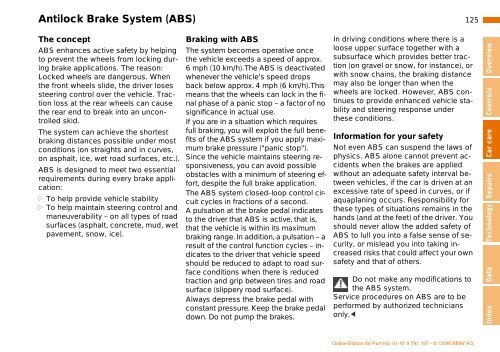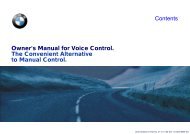Owner's Manual for the vehicle. With a quick reference ... - E38.org
Owner's Manual for the vehicle. With a quick reference ... - E38.org
Owner's Manual for the vehicle. With a quick reference ... - E38.org
You also want an ePaper? Increase the reach of your titles
YUMPU automatically turns print PDFs into web optimized ePapers that Google loves.
Antilock Brake System (ABS)<br />
125n<br />
The concept<br />
ABS enhances active safety by helping<br />
to prevent <strong>the</strong> wheels from locking during<br />
brake applications. The reason:<br />
Locked wheels are dangerous. When<br />
<strong>the</strong> front wheels slide, <strong>the</strong> driver loses<br />
steering control over <strong>the</strong> <strong>vehicle</strong>. Traction<br />
loss at <strong>the</strong> rear wheels can cause<br />
<strong>the</strong> rear end to break into an uncontrolled<br />
skid.<br />
The system can achieve <strong>the</strong> shortest<br />
braking distances possible under most<br />
conditions (on straights and in curves,<br />
on asphalt, ice, wet road surfaces, etc.).<br />
ABS is designed to meet two essential<br />
requirements during every brake application:<br />
> To help provide <strong>vehicle</strong> stability<br />
> To help maintain steering control and<br />
maneuverability – on all types of road<br />
surfaces (asphalt, concrete, mud, wet<br />
pavement, snow, ice).<br />
Braking with ABS<br />
The system becomes operative once<br />
<strong>the</strong> <strong>vehicle</strong> exceeds a speed of approx.<br />
6 mph (10 km/h). The ABS is deactivated<br />
whenever <strong>the</strong> <strong>vehicle</strong>'s speed drops<br />
back below approx. 4 mph (6 km/h). This<br />
means that <strong>the</strong> wheels can lock in <strong>the</strong> final<br />
phase of a panic stop – a factor of no<br />
significance in actual use.<br />
If you are in a situation which requires<br />
full braking, you will exploit <strong>the</strong> full benefits<br />
of <strong>the</strong> ABS system if you apply maximum<br />
brake pressure ("panic stop").<br />
Since <strong>the</strong> <strong>vehicle</strong> maintains steering responsiveness,<br />
you can avoid possible<br />
obstacles with a minimum of steering ef<strong>for</strong>t,<br />
despite <strong>the</strong> full brake application.<br />
The ABS system closed-loop control circuit<br />
cycles in fractions of a second.<br />
A pulsation at <strong>the</strong> brake pedal indicates<br />
to <strong>the</strong> driver that ABS is active, that is,<br />
that <strong>the</strong> <strong>vehicle</strong> is within its maximum<br />
braking range. In addition, a pulsation – a<br />
result of <strong>the</strong> control function cycles – indicates<br />
to <strong>the</strong> driver that <strong>vehicle</strong> speed<br />
should be reduced to adapt to road surface<br />
conditions when <strong>the</strong>re is reduced<br />
traction and grip between tires and road<br />
surface (slippery road surface).<br />
Always depress <strong>the</strong> brake pedal with<br />
constant pressure. Keep <strong>the</strong> brake pedal<br />
down. Do not pump <strong>the</strong> brakes.<br />
In driving conditions where <strong>the</strong>re is a<br />
loose upper surface toge<strong>the</strong>r with a<br />
subsurface which provides better traction<br />
(on gravel or snow, <strong>for</strong> instance), or<br />
with snow chains, <strong>the</strong> braking distance<br />
may also be longer than when <strong>the</strong><br />
wheels are locked. However, ABS continues<br />
to provide enhanced <strong>vehicle</strong> stability<br />
and steering response under<br />
<strong>the</strong>se conditions.<br />
In<strong>for</strong>mation <strong>for</strong> your safety<br />
Not even ABS can suspend <strong>the</strong> laws of<br />
physics. ABS alone cannot prevent accidents<br />
when <strong>the</strong> brakes are applied<br />
without an adequate safety interval between<br />
<strong>vehicle</strong>s, if <strong>the</strong> car is driven at an<br />
excessive rate of speed in curves, or if<br />
aquaplaning occurs. Responsibility <strong>for</strong><br />
<strong>the</strong>se types of situations remains in <strong>the</strong><br />
hands (and at <strong>the</strong> feet) of <strong>the</strong> driver. You<br />
should never allow <strong>the</strong> added safety of<br />
ABS to lull you into a false sense of security,<br />
or mislead you into taking increased<br />
risks that could affect your own<br />
safety and that of o<strong>the</strong>rs.<br />
Do not make any modifications to<br />
<strong>the</strong> ABS system.<br />
Service procedures on ABS are to be<br />
per<strong>for</strong>med by authorized technicians<br />
only.<<br />
Index Data Technology Repairs Car care Controls Overview



